Investing in regional Australia
Australia’s population is now over 25 million and is increasing at a rate of 1.6 per cent per annum. The demand for property in major cities is becoming increasingly competitive and expensive, which is why investors are looking to our nation’s regional centres for their next purchase.
Regional markets in Victoria and New South Wales are attracting the attention of investors Australia-wide.
When looking beyond the boundaries of Melbourne and Sydney, there are some sizeable changes on the horizon and plenty of plans in the pipeline that are pointing investors towards regional cities.
Population growth, infrastructure, employment opportunities, education facilities and housing affordability are just the beginning of what the City of Greater Geelong, Ballarat, Wollongong and Newcastle have to offer.
The City of Greater Geelong, Victoria
Median House Value (June 2019): $545,405
Gross Rental Yield (June 2019): 3.6 per cent
Located one hour south-west of Melbourne, the City of Greater Geelong covers an area of 1,247 square kilometres, comprising of suburban, coastal and county areas, making this a region that caters to a wide variety of industries and lifestyle preferences.
Capital growth in Greater Geelong has boomed over the past five years, with a forecast for the future looking just as expansive. Greater Geelong is earmarked to accommodate additional urban growth to ease development pressure on metropolitan Melbourne.
With a close proximity to Melbourne, a rapidly growing population, impeccable education facilities, employment opportunities, affordable property, and plans for major infrastructure updates, the City of Greater Geelong has plenty more to offer than just an enviable lifestyle.
Population
According to the National Institute of Property Research, the City of Greater Geelong has the fastest growing population in regional Victoria. With more than 50 suburbs and townships, the population of Greater Geelong is forecast to grow to 393,216 by 2041, according to the Australian Bureau of Statistics. That’s a 52.9 per cent increase from the population in June of 2019.
Education
Geelong’s education and training facilities cater to overseas and local student markets, providing a broad range of pathways from primary to tertiary education. There are over 50 kindergartens, over 70 primary schools, and over 20 secondary schools, including the elite private school, Geelong Grammar.
Deakin University was established in 1974 and continues to offer cutting-edge facilities and is internationally renowned for its research and teaching standards. Along with The Gordon that offers further education (TAFE) courses, there are also 35 privately operated and community based Registered Training Organisations in Geelong.
Employment
Geelong has a diverse economy with over 17,000 business enterprises. Key economic indicators show that Geelong has a strong local economy with an investment pipeline that will provide job opportunities into the future, particularly in emerging growth sectors.
Geelong’s major industries are education, health, advanced manufacturing, information communications and technology, and tourism. We are seeing some major businesses moving their head offices to Geelong due to feasibility. Reputable organisations include Cotton On, Target and the Transport Accident Commission (TAC).
Property
According to CoreLogic, the median house price in the City of Greater Geelong was $545,405 in June 2019 compared to $830,000 in metropolitan Melbourne — that’s a 31.6 per cent difference.
By 2021, the value of houses in Greater Geelong is forecast to increase by 7.6 per cent on average, according to a recent report by CoreLogic (see table below). If the average growth rate of houses continues at an average of 5.9 per cent per annum, we can expect a $567,000 property with compounding interest to be worth just over $1 million by 2030.
The majority of Greater Geelong’s suburbs see a gross rental yield of 3.6 per cent on average. Armstrong Creek is one of Geelong’s new estate developments that has yields at 3.7 per cent.

Infrastructure
$370 million is set to be injected into Geelong and surrounding areas for infrastructure planning and projects. Initiatives include a 1000-seat waterfront convention and exhibition centre to enhance Geelong’s position as a premier city, revitalisation of central Geelong and the city’s waterfront to improve access, support tourism, enhance community activity and major events, and the expansion of Deakin University’s Geelong Future Economy Precinct. These projects are set to create employment opportunities and attract more tourists to the region for years to come.
In the 2019-2020 Budget, the Australian Government allocated $2 billion for a high-speed rail network from Geelong's city centre to Melbourne’s CBD. This will be the first rail network of its kind in Australia, said to travel at 160km per hour. The 80 kilometre commute is proposed to be cut in half, taking just 32 minutes, according to Rail Projects Victoria. This will give more time back to commuters and will unlock new economic and social opportunities for the region. As documented in the Australian Government's Faster Rail Plan, funding for construction has proceeded. Matched funding from the Victorian Government is also being sought and contributions from the private sector will also be considered.
This investment builds on the Australian Government's landmark $5 billion commitment to deliver the Melbourne Airport Rail Link, which will include investigating options to increase capacity from Sunshine to the Melbourne CBD, enabling faster rail services from Geelong. The rapid population growth in the western region of Melbourne and constraints in existing infrastructure are impacting growth opportunities and the economic potential of the region. Transport connectivity between Geelong and Melbourne is constrained. Passenger rail services between Geelong and Southern Cross Station take approximately one hour at an average speed of between 70 and 80 kilometres per hour.
A report by the Victorian Auditor-General shows that during peak hour, the current rail service is often over capacity as passengers attempt to board trains at key outer metropolitan stations such as Wyndham Vale and Tarneit. Enabling more commuters to travel along the rail corridor from Geelong to Melbourne will also take pressure off the road corridor, further spreading the benefits of this investment.
In addition to this, Avalon Airport has recently begun offering international flights with Air Asia, further increasing tourism and accessibility to Geelong.
Ballarat, Victoria
Median House Value (June 2019): $414,005
Gross Rental Yield (June 2019): 4.4 per cent
Located 110km north-west of Melbourne, Ballarat covers an area of 740 square kilometres and has been identified in the State Government’s strategic plan for Melbourne as a major centre for future regional growth.
The regional municipality lies at the gateway to Western Victoria and provides many of the services, connections and economic drivers to support a greater region of approximately 400,000 people. Population growth is forecast to be major over the next decade, and strategic plans are in place to accommodate for this change.
Population
Ballarat is positioned amongst the top growth areas in regional Victoria. According to Regional Development Victoria, the population of Ballarat is estimated to grow at a rate of at least 1.8 per cent per annum until 2031, on par with the average annual growth that the region has experienced over the past 10 years.
Ballarat is estimated to grow to 144,596 residents by 2036, which is 30.72 per cent greater than the population in September 2019, according to the Australian Bureau of Statistics. The City of Ballarat has estimated that by 2040, the population will to grow by 60,000 people.
Education
Ballarat has a sound reputation for providing quality education. The region is home to 37 kindergartens, 55 primary schools and 10 secondary schools including Ballarat Grammar.
Australian Catholic University and Federation University are the two major universities in Ballarat. The City of Ballarat has plans to enhance the education sector of the area in order to support a vision for an improved city, as documented in the Ballarat Strategy 2040.
Employment
Ballarat is home to over 7,500 businesses. More than 90 per cent of residents who work in Ballarat, live in Ballarat according to a report by the City of Ballarat, although this is set to change once improvements in technology and transport increasingly enable businesses to tap into the Melbourne and global labour forces.
The major contributing industries are health care and social assistance, retail trade, education and training, construction and manufacturing. As the manufacturing and agricultural industries are experiencing major restructuring and change, Ballarat is now transitioning towards a focus on innovation: niche manufacturing, knowledge sector employment and service provision, particularly in health and aged care, as well as creative industries. The transition to many of these new industry sectors is largely driving the city’s current success and will be the foundations to prosperity over the medium to long-term.
Property
The median house price in Ballarat was $414,005 in June 2019, according to CoreLogic. By 2021, the value of houses in Ballarat is estimated to increase by 4.9 per cent on average, according to a recent report by CoreLogic (see table above). If the average growth rate of property continues at an average of 4.9 per cent per annum, we can expect a $450,000 property with compounding interest to be worth just over $723,975 by 2030.
Specific areas of interest in Ballarat are Alfredton, Lucas and Wendouree, all of which are within a 12 minute drive to the CBD. The median gross rental yield in Ballarat is 4.23 per cent.
Infrastructure
Ballarat is situated in a key position, with four main highways connecting the region to Melbourne and other major destinations. The Australian Government is investing in a variety of roadworks in Ballarat, many of which are currently under construction. The Victorian Government has provided $2 million to the City of Ballarat’s car parking strategy to deliver 1,000 new car parks across the city.
The Victorian Government has also contributed $47.8 million to develop the Ballarat GovHub which will be home to up to 1000 Victorian Government employees when complete in 2020, helping to revitalise a major part of the Ballarat CBD, regenerate long-term job growth, increase business confidence and further private sector investment.
The City of Ballarat’s Strategy outlines a comprehensive 25 plus year plan for managing future growth and change and covers planning for land use, settlement, housing (residential development, housing form and diversity), tourism, transport, and long-term sustainability.
Rail Projects Victoria are planning to implement a fast-rail to Ballarat from Melbourne and Geelong as a part of Victoria’s Big Build with $70 billion on transport projects being delivered across the state. The major fast-rail upgrade can only be implemented once new metro lines are built to Melton and Wyndham which are currently in planning. Rail upgrades to the Ballarat rail line are currently under construction, set to provide extra services for commuters.
The City of Wollongong, New South Wales
Median House Value in Wollongong (June 2019): $638,512
Gross Rental Yield (June 2019): 3.8 per cent
Wollongong is located in the Illawarra Region of New South Wales. The City of Wollongong encompasses a total land area of 714 square kilometres, including bushland, dams, cliffs and beaches. Wollongong City is a rural and residential area, with substantial industrial, port and commercial areas and water catchments. Urban development is mainly along the coast, between the Illawarra Escarpment in the west and the Tasman Sea in the east. Wollongong's CBD is just under 90 kilometres from Sydney.
Population
According to the Australian Bureau of Statistics, the population in the City of Wollongong in 2008 was 195,437. In October 2019, the population of Wollongong was 298,400, with an average annual population growth of 1.1 per cent over the last decade.
Education
Wollongong offers a variety of primary schools and high-schools including Smith's Hill High School, the Illawarra Sports High School and Illawarra Grammar School. Wollongong is home to Illawarra Institute of TAFE which offers a wide range of courses. The University of Wollongong ranks among the top 2 per cent of universities in the world with an enviable record in teaching and research. The University of Wollongong has over 36,000 students, more than 2,400 staff and contributes around $2 billion to the region annually. Graduates are recognised for their capability, quality and success in the global workplace, according to the City of Wollongong.
Employment
The size of Wollongong's economy is $11 billion, accounting for approximately 58 per cent of the Illawarra region's $19 billion economy. According to the Australian Bureau of Statistics, 100,787 people living in the City of Wollongong in 2018 were employed, of which 59 per cent worked full-time and 39 per cent worked part-time.
Wollongong’s city centre and the immediately surrounding suburbs are a critical employment area and is home to approximately 26,000 jobs. The major employment sectors in Wollongong are healthcare and social assistance, education and training, retail trade, manufacturing and construction. Wollongong has a large commuter pool, with around 17 per cent of residents across the wider region travelling to Greater Sydney for work each day.
Currently, for every 100 employed residents in Wollongong, there are 94 local jobs available. The City of Wollongong's Economic Development Strategy for 2019-2029 proposes that 10,500 jobs will be created over the next 10 years within the area.
Property
The table below is an overview of median property sales prices in the suburb of Wollongong from 2015-2019 (data sourced from CoreLogic).
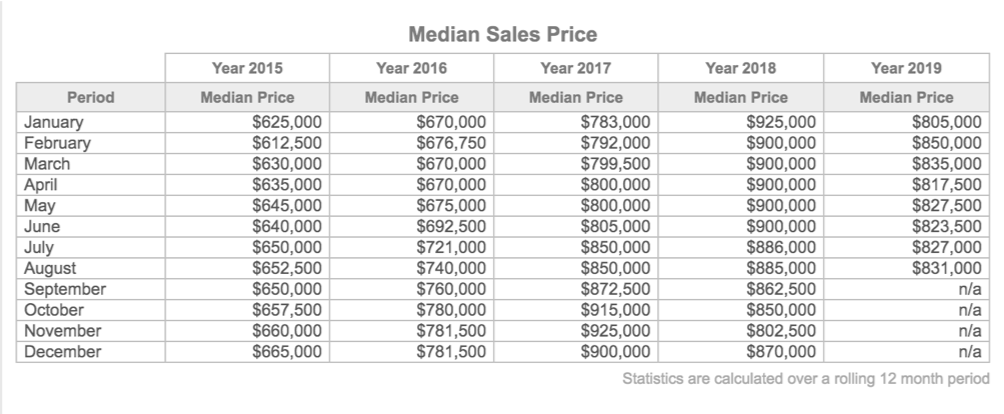
Wollongong has seen strong and consistent growth since 2015. Between August 2018 and August 2019, 40 properties were sold which is considerably less than the 90 properties that were sold in the August 2014 - August 2015 period.
The table below outlines house sales by price from August 2018 - August 2019.

According to QBE Insurance, the median house price in Wollongong is expected to rise by 6 per cent by 2022.
To compare these figures with house prices in Sydney, the table below outlines the median house prices in Sydney from December 2011 to June 2019.
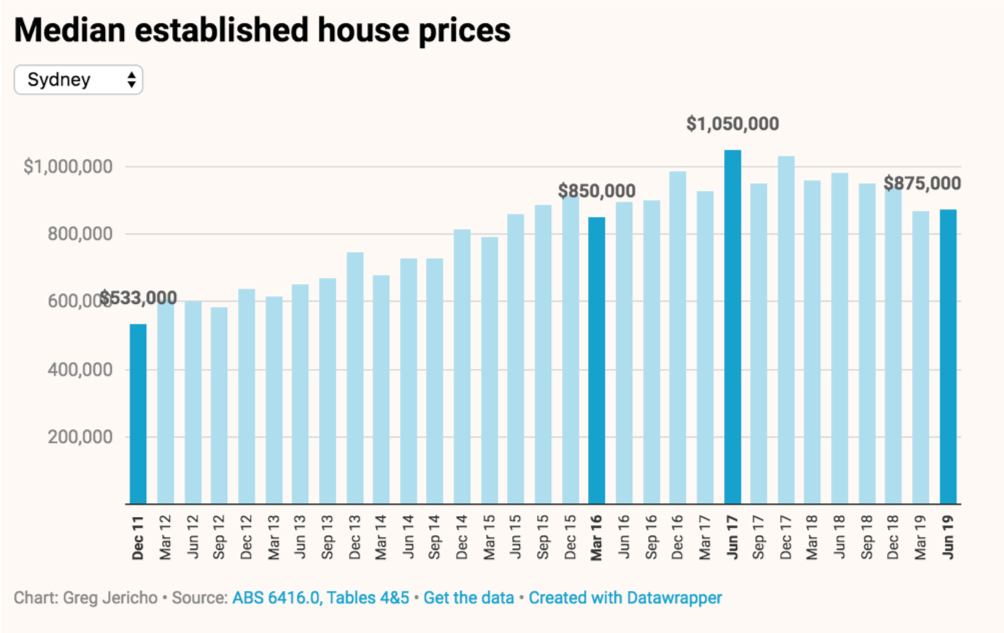
Infrastructure
The value of building approvals in Wollongong City was $155 million in the 2019-2020 September Fiscal Year-To-Date, according to the Australian Bureau of Statistics.
There are a number of transport projects that are critical to Wollongong and the broader region, all at various stages of planning, which have the potential to boost employment growth. These projects are largely focused on reducing travel times and congestion on the key arterial road and rail links between Illawarra and Greater Sydney.
The table below outlines transport projects for the Illawarra Region.
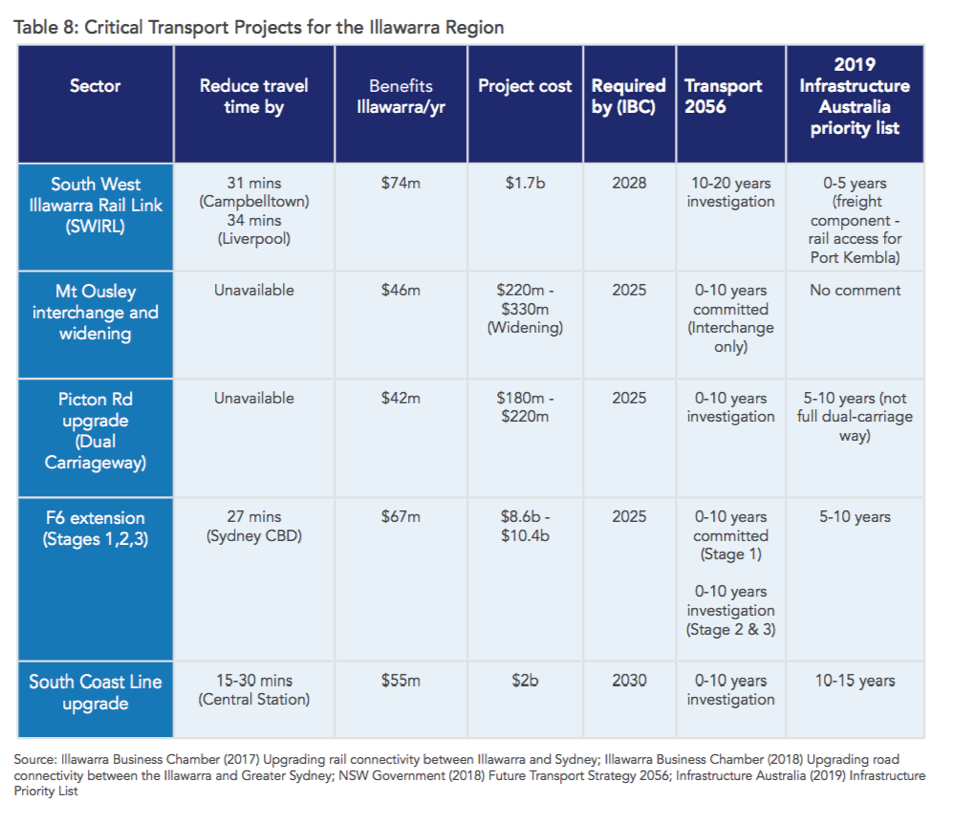
The new Western Sydney International (Nancy-Bird Walton) Airport is underway and on track to begin operations in 2026. The Aerotropolis will provide support for an estimated 200,000 new jobs by establishing a new high-skill jobs hub across aerospace and defence, manufacturing, healthcare, freight and logistics, agribusiness, education and research industries. There are direct opportunities for Wollongong based businesses during the construction phase of the airport and the Aerotropolis over the next decade. The emergence of this new city in Western Sydney provides further evidence why enhanced connectivity between Wollongong and Western Sydney is critical.
The Australian Government has committed to providing funding to develop a faster rail for the Sydney to Wollongong rail corridor. The current quality of the rail service in the Sydney to Wollongong corridor reflects a range of operational and infrastructure constraints including the Illawarra Escarpment and the single track Coalcliff Tunnel.
Uncompetitive rail services add to congestion on roads linking Sydney and Wollongong. A faster rail connection between Sydney and Wollongong would consolidate the corridor’s significant role to the nation’s economy and would unlock more affordable housing opportunities in the region by reducing journey times between Sydney and Wollongong from approximately one and a half hours to just over half an hour.
Newcastle, New South Wales
Median House Value (June 2019): $559,622
Gross Rental Yield (June 2019): 3.8 per cent
Newcastle is Australia's seventh-largest city and is located approximately 160 kilometres north of Sydney. The City of Newcastle covers an area of 187 square kilometres and is bounded by Maitland City and the Port Stephens Council area in the north, the Pacific Ocean in the east, Lake Macquarie City in the south, and Cessnock City in the west. Newcastle is the cultural and economic capital of the Hunter, Australia’s largest regional economy contributing around 8 per cent of the economic activity in New South Wales, with a regional output of approximately $44.5 billion in 2017.
Population
The population of The City of Newcastle in October 2019 was 166,984, and is forecast to grow to 202,049 by 2041, according to the Australian Bureau of Statistics. In addition to this, over 4 million tourists visit the area every year.
Education
There are a range of primary schools and high schools in the City of Newcastle. The two major independent schools are Newcastle Grammar School and St Philip's Christian College. The two major selective schools are Merewether High School and Hunter Sports High School.
There are three campuses of the Hunter Institute of TAFE, one located in the Newcastle CBD, one in the suburb of Hamilton East and the other located in the suburb of Tighes Hill. The Tighes Hill campus is the network's largest campus and offers courses in business, hospitality and various trades.
The city's predominant provider of tertiary education is the University of Newcastle. The University offers over 150 undergraduate and graduate courses to a student population of more than 38,000, including 7,000 international students from more than 113 countries. The University of Newcastle is currently expanding with investment in the landmark New Space campus complemented by Japan’s Nihon University choosing Greater Newcastle as its first campus in Australia. This is part of the new international focus for inner-city education in Greater Newcastle.
Employment
Data from the last Census in 2016 shows that 97,308 of people who worked in the City of Newcastle, 49.3 per cent of those people were also residents in the area. The major employment sectors in the City of Newcastle are healthcare and social assistance, retail trade, education and training and construction.
As a base for start-up businesses, Greater Newcastle's inner-city suburbs are increasingly becoming home to creative and innovative small businesses operating from refurbished industrial and manufacturing workshops.
Greater Newcastle’s diversified economy is expanding on strengths in health, education, defence, tourism and the creative sectors of the new economy. The University of Newcastle, Newcastle Airport, Newcastle Port and the John Hunter Hospital are key metropolitan assets providing opportunities to further grow the service economy and support the ongoing transition.
Property
Sales activity across the Newcastle and Lake Macquarie region has fallen by 15 per cent for houses over the year to May 2019, with current sales activity 18 per cent below the five year average for the region. Of the 6,628 dwelling sales (house and unit) that took place across the region, 5,376 were houses — that's 81 per cent. Newcastle and Lake Macquarie saw home values fall over the 12 months to June 2019, with house values down 8.8 per cent. The average time on market for homes in the region has increased by 18 days for houses, with the average vendor offering a greater discount to secure a sale when compared to May 2018. This information is depicted in the tables below. CoreLogic anticipates that the next quarter will show an increase in property values for Newcastle that we have so far been seeing until August.
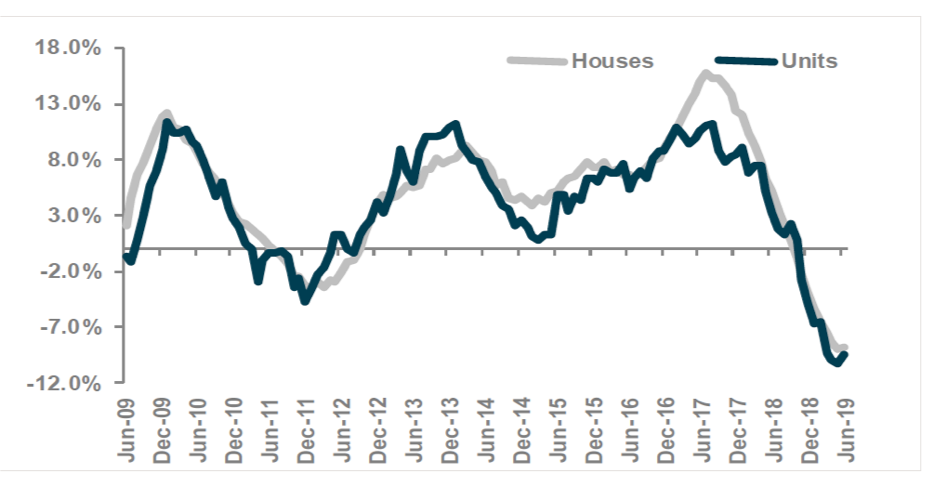
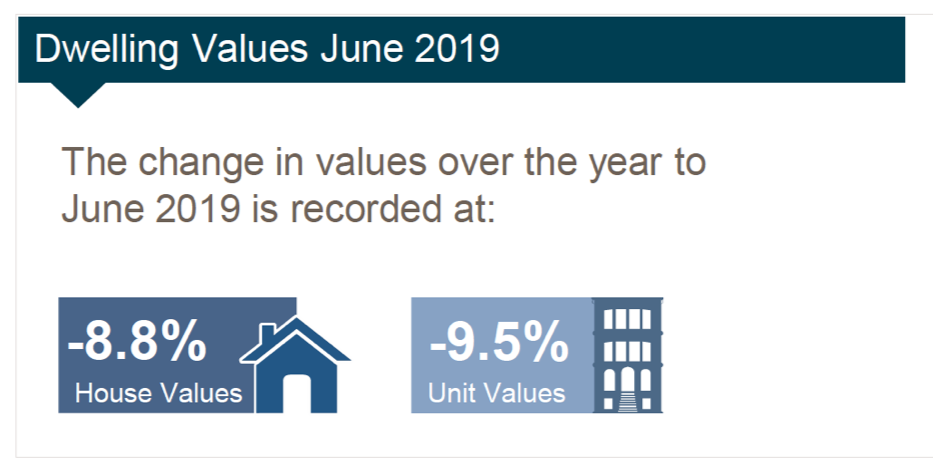
Infrastructure
The Greater Newcastle Metropolitan Plan 2036 outlines strategies and actions that will drive sustainable growth across the area. The plan states that around $650 million is being invested in the revitalisation of Newcastle's city centre. The major strategies for increasing growth are to reinforce the revitalisation of Newcastle's city centre and expand transformation along the waterside, grow the airport and aerospace and defence precinct at Williamtown, increase domestic and global trade capabilities at Newcastle Port, grow health precincts and connect the health network, expand education and innovation clusters, promote tourism, major events and sporting teams on the national and international stage, respond to the changing land use needs of the new economy, address changing retail consumer demand, plan for jobs closer to homes in the metro frame, along with a number of strategies to support the environment to become recognised as a more sustainable region.
The Greater Newcastle Metropolitan Plan 2036 forecasts the attraction of national corporate headquarters, expansion of tertiary education, tourism, small business and the services to support an additional 4,000 dwellings and accommodation for students, as well as new hotel developments.
Australia's population continues to climb
Australia's population has increased by almost five times over the last century. According to the Australian Government, over the past 10 years, 75 per cent of Australia’s population growth has occurred in our three largest capital cities and this trend is projected to continue.
Today, around 67 per cent of Australians live in capital cities, making Australia one of the most urbanised nations in the world. Most Australians live in our three largest cities of Sydney (21 per cent), Melbourne (20 per cent), Brisbane (10 per cent) and their surrounding regions (12 per cent).
By 2066, the Australian Bureau of Statistics projects Melbourne will grow to 10.2 million people, Sydney to 9.7 million and Brisbane to 4.8 million.
The likelihood of population growth that the City of Greater Geelong, Ballarat, Wollongong and Newcastle are going to see over the next decade is undeniable. With major plans for infrastructure, extensive transport upgrades, high-quality education facilities, employment opportunities, affordable housing, and a desirable lifestyle, investing in regional centres of Victoria and New South Wales could indeed be a calculated decision.
— with Carly Tomadin
Michael Mancuso is the Managing Director of PGA Advisory.















